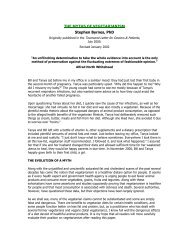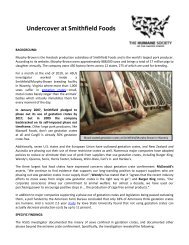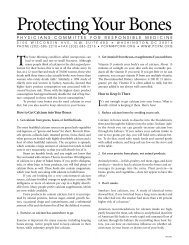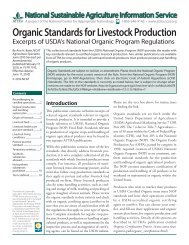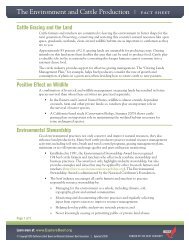Total Diet Approach to Communicating Food and Nutrition Information
Total Diet Approach to Communicating Food and Nutrition Information
Total Diet Approach to Communicating Food and Nutrition Information
- No tags were found...
You also want an ePaper? Increase the reach of your titles
YUMPU automatically turns print PDFs into web optimized ePapers that Google loves.
from the association ADA REPORTSPosition of the American <strong>Diet</strong>etic Association: <strong>Total</strong><strong>Diet</strong> <strong>Approach</strong> <strong>to</strong> <strong>Communicating</strong> <strong>Food</strong> <strong>and</strong> <strong>Nutrition</strong><strong>Information</strong>ABSTRACTIt is the position of the American <strong>Diet</strong>eticAssociation that the <strong>to</strong>tal die<strong>to</strong>r overall pattern of food eaten is themost important focus of a healthfuleating style. All foods can fit withinthis pattern, if consumed in moderationwith appropriate portion size <strong>and</strong>combined with regular physical activity.The American <strong>Diet</strong>etic Associationstrives <strong>to</strong> communicate healthfuleating messages <strong>to</strong> the public thatemphasize a balance of foods, ratherthan any one food or meal.Public policies that support the <strong>to</strong>taldiet approach include the <strong>Diet</strong>aryGuidelines for Americans, MyPyramid,the DASH <strong>Diet</strong> (<strong>Diet</strong>ary <strong>Approach</strong>es<strong>to</strong> S<strong>to</strong>p Hypertension), <strong>Diet</strong>aryReference Intakes, <strong>and</strong>nutrition labeling. The value of a foodshould be determined within the contex<strong>to</strong>f the <strong>to</strong>tal diet because classifyingfoods as “good” or “bad” may fosterunhealthful eating behaviors. Alternativeapproaches may be necessaryin some health conditions. Eatingpractices are dynamic <strong>and</strong> influencedby many fac<strong>to</strong>rs, including taste <strong>and</strong>food preferences, weight concerns,physiology, lifestyle, time challenges,economics, environment, attitudes<strong>and</strong> beliefs, social/cultural influences,media, food technology, <strong>and</strong> foodproduct safety. To increase the effectivenessof nutrition education in promotingsensible food choices, food <strong>and</strong>nutrition professionals should utilizeappropriate behavioral theory <strong>and</strong> evidence-basedstrategies. A focus onmoderation <strong>and</strong> proportionality in thecontext of a healthful lifestyle, ratherthan specific nutrients or foods, canhelp reduce consumer confusion. Proactive,empowering, <strong>and</strong> practical0002-8223/07/10707-0021$32.00/0doi: 10.1016/j.jada.2007.05.025messages that emphasize the <strong>to</strong>taldiet approach promote positive lifestylechanges.J Am <strong>Diet</strong> Assoc. 2007;107:1224-1232.POSITION STATEMENTIt is the position of the American <strong>Diet</strong>eticAssociation that the <strong>to</strong>tal diet oroverall pattern of food eaten is themost important focus of a healthfuleating style. All foods can fit withinthis pattern, if consumed in moderationwith appropriate portion size <strong>and</strong>combined with regular physical activity.The American <strong>Diet</strong>etic Associationstrives <strong>to</strong> communicate healthful eatingmessages <strong>to</strong> the public that emphasizea balance of foods, ratherthan any one food or meal.Over the past 4 decades, Americanshave become more consciousof diet <strong>and</strong> nutrition (1).Although nearly all consumers believethat body weight, diet, <strong>and</strong> physicalactivity influence health, diet surveyssuggest that their food habitsare not always commensurate withknowledge <strong>and</strong> beliefs (2). Only halfdescribe their diet as healthful, <strong>and</strong>14% eat five or more servings of fruits<strong>and</strong> vegetables per day. One thirdclassify themselves as sedentary <strong>and</strong>do not engage in physical activity.Even though more than half of consumerssay they are making dietarychanges <strong>to</strong> improve their health, approximatelytwo thirds are overweigh<strong>to</strong>r obese. It is clear that practicalguidance by food <strong>and</strong> nutritionprofessionals is needed <strong>to</strong> promotepositive lifestyle changes that aresustainable.According <strong>to</strong> the Shopping forHealth 2004 study, nearly six in 10consumers are trying hard <strong>to</strong> eathealthfully so they can avoid healthproblems later in life (3). More thanhalf of food shoppers strongly agreethat eating healthfully is a better way<strong>to</strong> manage illness than medication.Unfortunately, this trend <strong>to</strong>ward increasingawareness has been accompaniedby widespread confusion withcomplaints that nutrition educationis focused on what NOT <strong>to</strong> eat, insteadof what TO eat (1). These conflictingmessages make it difficult <strong>to</strong>know what <strong>to</strong> do.Eating is an important source ofpleasure. As food <strong>and</strong> nutrition professionalsstrive <strong>to</strong> improve the qualityof Americans’ dietary <strong>and</strong> lifestylechoices, challenges are exacerbatedby the widespread perception that individualsmust choose between goodtaste <strong>and</strong> nutritional quality. In fact,no single food or type of food ensuresgood health, just as no single food ortype of food is necessarily detrimental<strong>to</strong> health. Rather, the consistent excessof food, or absence of a type offood over time, may diminish the likelihoodof a healthful diet. For example,habitual, excessive consumptionof energy-dense foods may promoteweight gain <strong>and</strong> mask possible underconsumptionof essential nutrients.Yet small quantities of energy-densefoods on special occasions have no discernibleinfluence on health.In most situations, nutrition messagesare more effective when focusedon positive ways <strong>to</strong> make healthfulfood choices over time, rather thanindividual foods <strong>to</strong> be avoided (4,5).Unfortunately, the current mix of reliable<strong>and</strong> unreliable information ondiet <strong>and</strong> nutrition from a variety ofsources is confusing <strong>to</strong> the public <strong>and</strong>elicits negative feelings such as guilt,worry, helplessness, anger, fear, <strong>and</strong>inaction.The <strong>to</strong>tal diet approach is based onoverall eating patterns that have importantbenefits <strong>and</strong> health consequences<strong>and</strong> that provide adequate1224 Journal of the AMERICAN DIETETIC ASSOCIATION © 2007 by the American <strong>Diet</strong>etic Association
ADA REPORTSsituation such as a tempting food (eg,a cookie), loss of control may occur,depending on the individual’s emotionalstate, interpersonal conflict,<strong>and</strong> social pressure (23).In this scenario, a cookie would beregarded as a forbidden food <strong>and</strong> adieter who yields <strong>to</strong> a desire for acookie would tend <strong>to</strong> say, “I ate thecookie. I have blown my diet. I mightas well finish the rest of the box.” Thispessimistic approach becomes selffulfilling,as the subject believes thatthere is not much that can be doneonce a loss of control occurs (24). Askilled nutrition counselor might reducethe probability of relapse by increasingawareness of nutrition(knowledge), teaching coping skills(alternative behaviors), incorporatingpersonal favorites in individualizedeating patterns, <strong>and</strong> promoting acceptanceof personal responsibility<strong>and</strong> choice (“I can refuse <strong>to</strong> eat it” or “Ican occasionally enjoy a small portion”).The option of providing simple,one-size-fits-all decision rules may bean expedient approach <strong>to</strong> education<strong>and</strong> counseling, but it often misleadsconsumers in<strong>to</strong> thinking that a giventype of food is always a positive ornegative addition <strong>to</strong> the diet. The alternativeof offering more comprehensive<strong>and</strong> targeted education involvescontext-based judgment. This type ofeducational message is more difficult<strong>to</strong> address in language that is easy <strong>to</strong>underst<strong>and</strong> <strong>and</strong> apply, but it is morelikely <strong>to</strong> help the consumer <strong>to</strong> makewell-reasoned food choices <strong>and</strong> adoptbehavior patterns that are sustainableover time (17).All-Good or All-Bad <strong>Food</strong>s? Problems occurwhen a food or food component isoversimplified as all good or all bad.The increased risks for cardiovasculardisease associated with ingestionof trans fat produced during processingof foods might lead <strong>to</strong> the classificationof all trans fat as bad. However,a type of trans fat that occursnaturally from ruminant animalsources (dairy <strong>and</strong> meat), conjugatedlinoleic acid, has far different effectson metabolic function, genetic regulation,<strong>and</strong> physiological outcomes (25).In contrast <strong>to</strong> the atherogenic natureof most synthetic forms of trans fat,conjugated linoleic acid has beenshown <strong>to</strong> have beneficial effects oncardiovascular disease, diabetes, immuneresponse, energy distribution,<strong>and</strong> growth. To avoid this confusion,the <strong>Food</strong> <strong>and</strong> Drug Administrationhas excluded the naturally occurringtrans fat that is in a conjugated systemfrom its definition of trans fat fornutritional labeling (26).Conversely, even foods associatedwith a healthful diet such as eggwhites <strong>and</strong> soybeans should not beoversimplified as being perfect. Eggwhites are low in cholesterol <strong>and</strong> highin protein, yet they are also so low inzinc that they can induce a zinc-deficiencywhen used as a primary or solesource of protein in the diet (27). Similarly,soybeans have n-3 fatty acids,flavonoids, <strong>and</strong> phy<strong>to</strong>estrogens withhealth-promoting properties, but soyalso contains phytates that diminishabsorption of zinc <strong>and</strong> iron (28,29)<strong>and</strong> the health benefits of adding soy<strong>to</strong> the diet have not been consistentlysupported by research (30). For example,animal studies in which soy intakewas higher than that found inAsian diets found an increase in tumorgrowth (31). Thus, foods such asegg white <strong>and</strong> soy cannot be classifiedas completely good or bad, but rathertheir value is determined within thecontext of the <strong>to</strong>tal diet. Furthermore,lists of good <strong>and</strong> bad foods were consideredone of the “Ten Red Flags ofJunk Science” by the <strong>Food</strong> <strong>and</strong> <strong>Nutrition</strong>Science Alliance, a collaborationof seven scientific professional organizations(5).With over 45,000 food items in theaverage supermarket (32) <strong>and</strong> an infinitearray of recipe combinations,the futility of attempting <strong>to</strong> sort allfood items in<strong>to</strong> dicho<strong>to</strong>mous categoriesbecomes evident, leading <strong>to</strong> confusion<strong>and</strong> frustration. Thus, the <strong>to</strong>taldiet approach, with its emphasis onlong-term eating habits <strong>and</strong> a contextualapproach <strong>to</strong> food judgments suchas discretionary calories, providesmore useful information <strong>to</strong> guidelong-term food choices.CONTROVERSIES WITH THE TOTAL DIETAPPROACHOne concern with the <strong>to</strong>tal diet approachis that it may be viewed aspermitting unlimited inclusion of lownutrient-densityfoods <strong>and</strong> beveragesor encouraging overconsumption offoods with marginal nutritionalvalue. In a study using a <strong>Diet</strong>aryGuidelines index as a measure ofhealthful diet quality, heavy consumptionof savory, high-fat snackswas associated with poor diet quality(33). In addition, three national surveysof the US population have documentedthat portion sizes <strong>and</strong> energyintakes have increased substantiallyover time both inside <strong>and</strong> outside thehousehold (34). <strong>Nutrition</strong> education iscritical because individuals tend <strong>to</strong>eat more calories when served largeportions of foods, especially energydensefoods (35). Yet foods low in nutrientdensity can fit as part of the<strong>to</strong>tal diet, if these foods are consumedas discretionary calories in combinationwith appropriate quantities ofother recommended foods (36).Another controversy with the <strong>to</strong>taldiet approach is the emphasis on variety.Choosing a variety of foods hasbeen a corners<strong>to</strong>ne principle in the<strong>Diet</strong>ary Guidelines for Americans, butthat emphasis has changed fromoverall variety <strong>to</strong> varying choiceswithin the food groups. Choosing avariety of nutrient-dense foods helps<strong>to</strong> ensure adequate intakes of morethan 50 nutrients that are needed forgrowth, repair, <strong>and</strong> maintenance ofgood health. However, an increase infood availability <strong>and</strong> variety in foodchoices may be a cause of overeating,especially when applied <strong>to</strong> energydensefoods (37). For example, themultitude of choices at a buffet <strong>and</strong>the temptation <strong>to</strong> taste each food canresult in a greater intake of caloriesthan from a plated or family-stylemeal. When McCrory <strong>and</strong> colleagues(38) analyzed 1999 food consumptiondata, increases in energy intakes <strong>and</strong>body fatness were associated with ingestionof a high variety of sweets,snacks, condiments, entrees, <strong>and</strong> carbohydratefoods, coupled with a limitedvariety of vegetables. Krebs-Smith <strong>and</strong> colleagues (39) observedthat a variety of foods was associatedwith nutrient adequacy <strong>to</strong> a point, beyondwhich there was no improvement.When nutrient needs are satisfied,eating additional foods providesexcess calories without added healthbenefits.WHY WE EAT WHAT WE DOConvenience, Cost, <strong>and</strong> ConfusionAlthough 87% of consumers reportedbeing very or somewhat concernedabout nutrition, widespread improvementsin dietary changes have no<strong>to</strong>ccurred (2). Shoppers say healthful1226 July 2007 Volume 107 Number 7
ADA REPORTSeconomic fac<strong>to</strong>rs were the most importantissue facing this country; by1999, only 12% held this belief (59). Inindividuals with lower incomes, convenienceis rated as a more importantinfluence on food choices as comparedwith those with higher incomes (62),reflecting limitations in transportation,cooking facilities, food preparationskills, grocery s<strong>to</strong>re locations,<strong>and</strong> availability of healthful foodchoices (63,64). However, financial issueswere associated with limitedcompliance with dietary guidelines ina recent study of low-income women(65).Environmental Fac<strong>to</strong>rsAttitudes <strong>and</strong> Beliefs. Attitudes <strong>and</strong> beliefsabout foods tend <strong>to</strong> reflect culturalvalues, but they change morequickly with time (66). For example,perceptions, attitudes, <strong>and</strong> beliefsabout fat have shifted in the last halfof this century, much of it because ofsocial trends <strong>and</strong> marketing campaigns.Also, the typical “meat <strong>and</strong>pota<strong>to</strong>es” plates have been replacedby varying cuisines <strong>and</strong> preparationtechniques (67). An illustration is a1950s restaurant meal of beef steak,fried onion rings, lettuce wedge withThous<strong>and</strong> Isl<strong>and</strong> dressing, <strong>and</strong> bakedpota<strong>to</strong>es with butter, cheese, <strong>and</strong> sourcream. Today, meals might be lowerin fat <strong>and</strong> reflect changing tastes,such as pasta with chicken, sun-dried<strong>to</strong>ma<strong>to</strong>es, <strong>and</strong> roasted vegetables, accompaniedby a salad of mixed fieldgreens, dried cranberries, <strong>and</strong> balsamicdressing.Social Influences. Social fac<strong>to</strong>rs substantiallyinfluence eating behaviors.For example, the presence of a friend(but not a stranger) while eating increasesenergy intake by 18%. Thisstudy suggested that social facilitationof eating is caused by an impairedability <strong>to</strong> self-moni<strong>to</strong>r (68). Ina study of why cardiac patients do notfollow nutritional advice, 86% reportedthat social <strong>and</strong> work situationspresented challenges, in addition <strong>to</strong>financial barriers <strong>to</strong> change <strong>and</strong> difficultywith restraint when facing largeamounts of food (69).Media. The media is a powerful forceinfluencing the food choices of Americans.In 2004 approximately $11 billionwas spent for food, beverage, <strong>and</strong>restaurant advertising in magazines,newspapers, television, <strong>and</strong> radio (70).When Kellogg’s high-fiber cerealsfirst added health claims about cancerprevention <strong>and</strong> dietary fiber <strong>to</strong>their package label, sales escalated47% within the first 6 months (71).Trade association programs have promotedgeneric advertising, such asthe one for fluid milk (“Got Milk?”),which featured celebrities wearingmilk mustaches. Remarkably, thesecampaigns slowed or s<strong>to</strong>pped the decliningtrend of milk consumption<strong>and</strong> 47 lb of milk were purchased foreach advertising dollar spent (72).Thus, consumers can change theirperceptions of foods <strong>and</strong> food choiceswhen given repeated <strong>and</strong> positive nutritionmessages.Product Safety. Concerns about productsafety can affect food choices profoundly.For example, the 1988 scareof Alar (Chemtura Corporation,Middlebury, CT) in apples resulted innear hysteria among mothers whothought they had fed their childrentainted foods. Apple sales plummetedas a result, even though the researchbehind the scare was controversial.When Alar (a plant growth regula<strong>to</strong>r)was removed from use in some states<strong>and</strong> the perceived risk of cancer minimized,consumers returned <strong>to</strong> eatingapples as in the past (73). Although itis essential <strong>to</strong> acknowledge that trulyunsafe foods are never good foodchoices, in this case, positive messagesabout the benefits of diets withplenty of fruits <strong>and</strong> vegetables helpres<strong>to</strong>re balance in diet <strong>and</strong> healthgoals.COMPLEXITIES OF CHANGING EATINGBEHAVIORSThe impact of nutrition informationon promoting healthful lifestyles dependson how effectively nutritionmessages are communicated <strong>to</strong> consumers.<strong>Nutrition</strong> information mustbe presented with sufficient context <strong>to</strong>provide consumers with a broader underst<strong>and</strong>ingof the issues <strong>and</strong> <strong>to</strong> determinewhether it applies <strong>to</strong> theirunique needs (4). Communications<strong>and</strong> educational programs must emphasizethe importance of consideringa food or meal in terms of its contributions<strong>to</strong> the <strong>to</strong>tal diet. This type ofcommunication can be more effectivewhen educa<strong>to</strong>rs use appropriate theories<strong>and</strong> models of fac<strong>to</strong>rs related <strong>to</strong>human behavior (18). Although providinginformation can be effective inpromoting healthful behaviors, communicationsdesigned <strong>to</strong> build skillsor help learners master more complexconcepts usually benefit from the inclusionof principles from health-behaviortheories <strong>and</strong> models (Figure).Adapting Behavior-Oriented Theories for<strong>Food</strong> <strong>and</strong> <strong>Nutrition</strong> CommunicationKnowledge-Attitude-Beliefs. One of thesimplest models for food <strong>and</strong> nutritioncommunication is the Knowledge-Attitude-Beliefsapproach, which is basedon the often-mistaken assumption thatthe person who is exposed <strong>to</strong> new informationwill attend <strong>to</strong> it, gain newknowledge, change attitude, <strong>and</strong> improvedietary patterns (20). This approachcan be effective if the individualis already motivated <strong>and</strong> the new informationis easy <strong>to</strong> follow. For example, alist of foods that are high in iron may bea successful trigger <strong>to</strong> dietary improvementfor someone concerned over a recentdiagnosis of anemia. However,without such a “teachable moment,” increasedknowledge, such as a memorizedlist of high-iron foods, often fails<strong>to</strong> result in changed behavior. This istrue especially if following the advice isnot convenient or congruent with personaltaste preferences.Health-Belief Model. The Health-BeliefModel is one of the most widely usedtheories in health education (74). Anexample is the promotion of foodshigh in folate <strong>to</strong> reduce the risk ofcertain birth defects. This model explainshuman behavior <strong>and</strong> readiness<strong>to</strong> act via four main constructs: perceivedsusceptibility (“How likely amI <strong>to</strong> get heart disease <strong>and</strong> how soon?”),severity (“How bad would it be <strong>to</strong>have heart disease?”), benefits (“WillI feel better if I change the fats thatI eat?”), <strong>and</strong> barriers (“How hard willit be <strong>to</strong> make these changes in myfat intake?”). A recent addition <strong>to</strong> theHealth-Belief Model is the concept ofself-efficacy (“How confident am I thatI can succeed in changing the fatsthat I eat?”). The Health-BeliefModel is useful when the target audienceperceives a problem behavioror condition in terms of health motivation.Yet many consumers “tuneout” repeated messages of gloom<strong>and</strong> doom for habits that seem common<strong>and</strong> without immediate negativeconsequences.1228 July 2007 Volume 107 Number 7
ADA REPORTSI realize that eating whole fruit is a good way <strong>to</strong> help me increase my intakeof fruits <strong>and</strong> vegetables each day. I also realize that I have been gettingmost of my fruit in the form of juice. I will start buying more whole fruit <strong>and</strong>less juice the next time I go <strong>to</strong> the supermarket.Stages <strong>and</strong> processes of changeTranstheoretical ModelIf the vending machines at my office have fruit, I will be more likely <strong>to</strong>select it as a snack.Reciprocal determinismSocial Cognitive TheorySocial Cognitive Theory/Transtheoretical Theory.When problem behaviors areclosely tied <strong>to</strong> social or economic motivations,more comprehensive theories<strong>and</strong> models may be effective <strong>to</strong>olsfor planning nutrition interventions(75). For instance, if an educa<strong>to</strong>rneeds <strong>to</strong> promote milk-based foods assources of dietary calcium, SocialCognitive (Social Learning) Theorywould support an educational interventionaddressing behavioral capability(knowledge <strong>and</strong> skills needed <strong>to</strong>select <strong>and</strong> prepare milk-based foods),11I know that I can eat more fruit <strong>and</strong> less juice by learning which fruits are inseason <strong>and</strong> putting those fruits on my weekly shopping list.Self-efficacySocial Learning Theory, Transtheoretical, <strong>and</strong> Health-Belief Models1Whole fruits have fiber that helps me feel full. If I drink juice instead ofeating whole fruit, I would get less fiber <strong>and</strong> have a harder time managingmy calorie intake. That could lead <strong>to</strong> gaining excess weight which wouldmake me feel less attractive. However, I may not be able <strong>to</strong> eat whole fruitas often as I want <strong>to</strong> because it is easier <strong>to</strong> find fruit juice when I needsomething that’s fast <strong>and</strong> easy from a vending machine or a conveniences<strong>to</strong>re.Perceived benefits, threats, <strong>and</strong> barriersHealth-Belief ModelCalorie per calorie, whole fruit has more dietary fiber than fruit juice.Health informationKnowledge-Attitude-Behavior1Figure. Example of how behavioral models can be used <strong>to</strong> provide positive nutrition messagesfor increasing consumption of fruit (eg, eating whole fruit more often than juice). Each level addsimportant concepts <strong>to</strong> fac<strong>to</strong>rs addressed by models on the levels below it.reciprocal determinism (availabilityof milk-based foods in vending machines<strong>and</strong> restaurants), expectations(beliefs about osteoporosis as a consequenceof avoiding milk-based foods),self-efficacy (confidence in one’s ability<strong>to</strong> use more milk-based foods), observationallearning or modeling (seeingpeers <strong>and</strong> other role modelsdrinking milk), <strong>and</strong> reinforcement(positive or negative feelings that occurwhen milk drinking is practiced).The Transtheoretical Model/Stageof Change (76) describes learners interms of their progress through a seriesof behavioral stages (stages ofchange). It also includes related dimensionssuch as processes of change,self-efficacy, <strong>and</strong> decisional balance(pros/cons) <strong>and</strong> allows educa<strong>to</strong>rs <strong>to</strong>tailor educational messages <strong>to</strong> learners’needs <strong>and</strong> readiness for behavioralchange.Social Marketing. Social marketing is abehaviorally focused process thatadapts commercial marketing techniques<strong>to</strong> programs designed <strong>to</strong> influencethe behavior of target audiences<strong>to</strong> improve their well-being. Socialmarketers work <strong>to</strong> create <strong>and</strong> maintainexchanges of target audience resources,such as money or time, forperceived benefits such as feeling betteror having more independence.Just as educa<strong>to</strong>rs may use a range oftheoretical concepts <strong>to</strong> design effectiveinterventions, marketing campaignsalso may be more effectivewhen important determinants of behaviorare identified <strong>and</strong> used in amedia campaign (77).The Fruits <strong>and</strong> Veggies: More Matterscampaign <strong>and</strong> its predecessor,the 5-A-Day for Better Health campaign,are examples that adapt marketingtheory <strong>to</strong> food <strong>and</strong> nutritioncommunication (78). Designers ofthese campaigns studied the preferences<strong>and</strong> habits of various audiencesegments; developed messages thatwould be perceived as relevant, comprehensible,<strong>and</strong> actionable; <strong>and</strong> thendistributed these <strong>to</strong> consumers in settingssuch as supermarkets, restaurants,<strong>and</strong> the Internet (79). The effectivenessof these campaigns inincreasing Americans’ consumptionof fruits <strong>and</strong> vegetables is wellknown.Regardless of the theoretical basisof communications, messages must beconsistent with an emphasis on a <strong>to</strong>taldietary pattern that is balanced<strong>and</strong> moderate, <strong>and</strong> guard against inadvertentuse of oversimplified messagessuch as good/bad foods. Otherwise,communica<strong>to</strong>rs may not beeffective in achieving their educationalgoals (80).The Socio-Ecological DimensionIn addition <strong>to</strong> programs that targetbehavioral practices <strong>and</strong> dietaryknowledge/skills of individuals <strong>and</strong>families, it is often appropriate <strong>to</strong> promotebehavioral changes <strong>and</strong> dietaryJuly 2007 ● Journal of the AMERICAN DIETETIC ASSOCIATION 1229
ADA REPORTSimprovements at the broader organizationalor societal levels. A socio-ecologicalmodel has been developed <strong>to</strong>guide programs that facilitate choicesof targeted systems, environment,<strong>and</strong> public policy change within organizationsat the community <strong>and</strong> statelevels (81).REDUCING NUTRITION CONFUSIONTo reduce confusion from the highvolume <strong>and</strong> apparent inconsistenciesof nutrition advice, the followingshould be considered when designingnutrition education for the public:● Promote variety, proportionality,moderation, <strong>and</strong> gradual improvement.Variety refers <strong>to</strong> an eatingpattern that includes foods from allMyPyramid food groups <strong>and</strong> subgroups.Proportionality, or balance,means eating more of some foods(fruits, vegetables, whole grains,fat-free or low-fat milk products),<strong>and</strong> less of others (foods high in saturatedor trans fats, added sugars,cholesterol, salt, <strong>and</strong> alcohol). Moderationmay be accomplishedthrough advice <strong>to</strong> consumers <strong>to</strong>limit overall portion size <strong>and</strong> <strong>to</strong>choose foods that will limit intake ofsaturated or trans fats, added sugars,cholesterol, salt, <strong>and</strong> alcohol.To make gradual improvement, individualscan take small steps <strong>to</strong>improve their diet <strong>and</strong> lifestyleeach day (16).● Emphasize food patterns, ratherthan individual nutrients or individualfoods, as key considerationsin evaluating <strong>and</strong> planning one’sfood choices. Be aware of the social,cultural, economic, <strong>and</strong> emotionalmeanings that may be attached <strong>to</strong>some foods <strong>and</strong> allow for flexibilitywhenever possible. Underst<strong>and</strong>that social <strong>and</strong> cultural aspects offood consumption are essential forplanning educational programs <strong>to</strong>help correct nutritional problems ofindividuals <strong>and</strong> population groups(82).● Acknowledge the importance of obtainingnutrients from foods, ratherthan relying on nutrients from supplementsor fortified foods. Althoughnutrient modifications arerecommended when food intake isinadequate <strong>to</strong> meet specific needs(eg, iron, folic acid, vitamins B-12<strong>and</strong> D for some population groups),it is important <strong>to</strong> stress that a dietbased on a wide variety of foods remainsthe preferred overall sourceof nutrients (83). Numerous bioactivecompounds in foods such asphy<strong>to</strong>chemicals <strong>and</strong> ultra trace elementshave been identified thathave potential health benefits. Yetthe precise role, dietary requirements,influence on other nutrients,<strong>and</strong> <strong>to</strong>xicity levels of these dietarycomponents are still unclear. Furthermore,foods may contain additionalnutritional substances thathave not yet been discovered. Thus,appropriate food choices, ratherthan supplements, should be thefoundation for achieving nutritionaladequacy (7).● Stress that physical activity complementsthe <strong>to</strong>tal diet approachbecause it permits individuals <strong>to</strong>help manage weight <strong>and</strong> lowers therisk of premature diseases. Theminimum amount recommendedfor health benefits by MyPyramid<strong>and</strong> the <strong>Diet</strong>ary Guidelines forAmericans is 30 minutes, preferablyeach day. To avoid weight gain,60 minutes per day may be necessary,<strong>and</strong> this may increase up <strong>to</strong> 90minutes <strong>to</strong> maintain weight loss.ROLE OF FOOD AND NUTRITIONPROFESSIONALS<strong>Food</strong> <strong>and</strong> nutrition professionals havea responsibility <strong>to</strong> communicate unbiasedfood <strong>and</strong> nutrition informationthat is culturally sensitive, scientificallyaccurate, medically appropriate,<strong>and</strong> feasible for the target audience.Some health <strong>and</strong> nutrition experts<strong>and</strong> many “pseudo-experts” promotespecific foods or types of food <strong>to</strong> chooseor avoid in order <strong>to</strong> improve health. Amore responsible <strong>and</strong> effective approachis <strong>to</strong> help consumers underst<strong>and</strong><strong>and</strong> apply the principles ofhealthful diet <strong>and</strong> lifestyle choices.Unless there are extenuating circumstances(eg, individuals with severecognitive or physical limitations suchas dementia or renal failure), the <strong>to</strong>taldiet approach is preferred becauseit is more consistent with research oneffective communication <strong>and</strong> inclusiveof cultural/personal differences.To achieve this goal, the Board of theAmerican <strong>Diet</strong>etic Association approvedthe objective <strong>to</strong> focus nutritionmessages on <strong>to</strong>tal diet, not individualfoods (84).Effective Communication StrategiesTo be communicated effectively, educationalmessages <strong>and</strong> counseling interventionsshould:● focus on high-priority personal<strong>and</strong>/or public health needs;● provide a proactive, positive, <strong>and</strong>practical approach;● promote an enjoyable pattern ofdiet <strong>and</strong> activity choices as part of along-term overall healthful lifestyle;● use successful educational strategiesbased on theories <strong>and</strong> modelsthat promote behavioral change;<strong>and</strong>● evaluate <strong>and</strong> share information oneffectiveness of food <strong>and</strong> nutritionprograms.As leaders in nutrition communication,food <strong>and</strong> nutrition professionalsneed <strong>to</strong> continue strengthening skills,updating competencies, <strong>and</strong> documentingoutcomes. Suggested techniques<strong>to</strong> achieve these goals are:● build coalitions with industry, government,academia, <strong>and</strong> organizations;● use a full range of available <strong>and</strong>appropriate communication technologies<strong>and</strong> take advantage of opportunities<strong>to</strong> communicate withprofessional colleagues <strong>and</strong> thepublic, such as giving presentations<strong>and</strong> writing publications <strong>to</strong> influencesocial norms <strong>and</strong> public policy;● act as role models of active participationin local <strong>and</strong> professional associations;● maintain state-of-the-art knowledgethrough continuing education;<strong>and</strong>● take a professional <strong>and</strong> unbiasedapproach <strong>to</strong> promoting healthfuleating <strong>and</strong> physical activitypatterns.References1. American <strong>Diet</strong>etic Association. <strong>Nutrition</strong><strong>and</strong> You: Trends 2002 Final Report of Findings.Oc<strong>to</strong>ber 2002. Available at: http://www.eatright.org/cps/rde/xchq/ada/hs.xsl/media_1578_ENU_HTML.htm. Accessed June 10,2006.2. International <strong>Food</strong> <strong>Information</strong> Council.<strong>Food</strong> & Health Survey: Consumer Attitudes<strong>to</strong>ward <strong>Food</strong>, <strong>Nutrition</strong> & Health. 2006.Available at: http://www.ific.org/research/food<strong>and</strong>healthsurvey.cfm#EXECUTIVE%20SUMMARY. Accessed August 28, 2006.1230 July 2007 Volume 107 Number 7
ADA REPORTS3. <strong>Food</strong> Marketing Institute. SuperMarket Research.Volume 6, Number 2, Summer 2004.Available at: http://www.fmi.org/newsletters/uploads/SupermarketResearch/SMRSummer04.pdf Accessed June 21, 2006.4. American <strong>Diet</strong>etic Association. Position ofthe American <strong>Diet</strong>etic Association: <strong>Food</strong> <strong>and</strong>nutrition misinformation. J Am <strong>Diet</strong> Assoc.2006;106:601-607. Available at: http://www.eatright.org/cps/rde/xchg/ada/hs.xsl/advocacy_adar0202_ENU_HTML.htm. Accessed June21, 2006.5. International <strong>Food</strong> <strong>Information</strong> Council.How consumers feel about food <strong>and</strong> nutritionmessages. February 2002. Available at:http://www.ific.org/research/newconvres.cfm.Accessed June 21, 2006.6. American <strong>Diet</strong>etic Association. Position ofthe American <strong>Diet</strong>etic Association: Fortification<strong>and</strong> nutritional supplements. J Am <strong>Diet</strong>Assoc. 2005;105:1300-1311.7. US Department of Health <strong>and</strong> Human Services,US Department of Agriculture. <strong>Diet</strong>aryGuidelines for Americans 2005. 6th edition.Available at: http://www.healthierus.gov/dietaryguidelines. Accessed June 21, 2006.8. US Department of Agriculture. MyPyramid<strong>Food</strong> Guidance System. 2005. Available at:http://www.mypyramid.gov. Accessed June21, 2006.9. US Department of Health <strong>and</strong> Human Services.DASH Eating Plan. 2006. Availableat: http://www.nhlbi.nih.gov/health/public/heart/hbp/dash/new_dash.pdf. Accessed August28, 2006.10. <strong>Food</strong> <strong>and</strong> Drug Administration. How <strong>to</strong> underst<strong>and</strong><strong>and</strong> use the nutrition facts label. . .Updated November 2004. Available at:http://www.cfsan.fda.gov/dms/foodlab.html.Accessed June 21, 2006.11. International <strong>Food</strong> <strong>Information</strong> Council, <strong>Food</strong>Marketing Institute, US Department of Agriculture.Your personal plan <strong>to</strong> health: Steps <strong>to</strong>a healthier you [brochure]. 2006. Available at:http://www.ific.org/publications/brochures/upload/MyPyramidBrochure.pdf. AccessedAugust 28, 2006.12. King S, Gibney M. <strong>Diet</strong>ary advice <strong>to</strong> reducefat intake is more successful when it doesnot restrict habitual eating patterns. JAm<strong>Diet</strong> Assoc. 1999;99:685-689.13. Welsh S, Davis C, Shaw A. Development ofthe <strong>Food</strong> Guide Pyramid. Nutr Today. 1992;27:12-23.14. <strong>Diet</strong>ary Guidelines Advisory Committee. Repor<strong>to</strong>f the <strong>Diet</strong>ary Guidelines Advisory Committeeon the <strong>Diet</strong>ary Guidelines for Americans,2005. Beltsville, MD: US Departmen<strong>to</strong>f Agriculture, Agricultural Research Service;2004.15. Crane NT, Hubbard VS, Lewis CJ. Americ<strong>and</strong>iets <strong>and</strong> year 2000 goals. In: Frazao E,ed. America’s Eating Habits: Changes &Consequences. Washing<strong>to</strong>n, DC: US Departmen<strong>to</strong>f Agriculture; 1999:111-133. Agriculture<strong>Information</strong> Bulletin No. 750.16. Committee on <strong>Diet</strong>ary Reference Intakes.<strong>Diet</strong>ary Reference Intakes for Calcium, Phosphorus,Magnesium, Vitamin D, <strong>and</strong> Fluoride.Washing<strong>to</strong>n, DC: National AcademiesPress; 1997.17. Sahyoun NR, Pratt CA, Anderson A. Evaluationof nutrition education interventionsfor older adults: A proposed framework.J Am <strong>Diet</strong> Assoc. 2004;104:58-69.18. American <strong>Diet</strong>etic Association. Position ofthe American <strong>Diet</strong>etic Association: The rolesof registered dietitians <strong>and</strong> dietetic technicians,registered in health promotion <strong>and</strong>disease prevention. J Am <strong>Diet</strong> Assoc.2006;106:1875-1884.19. American <strong>Diet</strong>etic Association. Former positionof the American <strong>Diet</strong>etic Association:<strong>Nutrition</strong> education for the public. J Am<strong>Diet</strong> Assoc. 1996;96:1183-1187.20. Conten<strong>to</strong> I, Balch GI, Bronner YL, Lytle LA,Maloney SK, Olson CM, Swadener SS. Theoreticalframeworks or models for nutritioneducation. J Nutr Educ. 1995;27:287-290.21. Lytle LA, Eldridge AL, Kotz K, Piper ??,Williams S, Kalina B. Children’s interpretationof nutrition messages. J Nutr Educ.1997;29:128-136.22. O’Dea JA. Children <strong>and</strong> adolescents identifyfood concerns, forbidden foods, <strong>and</strong> food-relatedbeliefs. J Am <strong>Diet</strong> Assoc. 1999;99:970-973.23. Marlatt GA. Relapse prevention: Theoreticalrationale <strong>and</strong> overview of the model. In:Marlatt CA, Gordon JR, eds. Relapse Prevention.New York, NY: Guilford Press;1985:3-70.24. Zywiak WH, Connors GJ, Mais<strong>to</strong> SA, WesterbergVS. Relapse research <strong>and</strong> the Reasonsfor Drinking Questionnaire: A fac<strong>to</strong>ranalysis of Marlatt’s relapse taxonomy. Addiction.1996;91(suppl):S121-S130.25. Belury M. Not all trans-fatty acids are alike:What consumers may lose when we oversimplifynutrition facts. J Am <strong>Diet</strong> Assoc. 2002;102:1606-1607.26. Federal Register. 21CFR. 101.9 (c) (2) (i)Trans Fatty Acids in <strong>Nutrition</strong>al Labeling.Available at: http://www.cfsan.fda.gov/acrobat/fr03711a.pdf. Accessed February 8,2007.27. Freel<strong>and</strong>-Graves J, Hendrickson PJ, EbangitML, Snowden JY. Salivary zinc as anindex of zinc status in women fed a low-zincdiet. Am J Clin Nutr. 1981;34:312-321.28. Liener IE. Possible adverse effects of soybeananticarcinogens. J Nutr. 1995;125(suppl 3):744S-750S.29. Freel<strong>and</strong>-Graves J. Mineral adequacy ofvegetarian diets. Am J Clin Nutr. 1988;48(suppl 3):859-862.30. Sacks FM, Lichtenstein A, Van Horn L, HarrisW, Kris-Ether<strong>to</strong>n P, Wins<strong>to</strong>n M. Soy protein,isoflavones, <strong>and</strong> cardiovascular health:A summary of a statement for professionalsfrom the American Heart Association <strong>Nutrition</strong>Committee. Arterioscler Thromb VascBiol. 2006;26:1689-1692.31. Trock BJ, Hilakivi-Clarke L, Clarke R.Meta-analysis of soy intake <strong>and</strong> breast cancerrisk. J Natl Cancer Inst. 2006;98:459-471.32. <strong>Food</strong> Marketing Institute. Supermarketfacts: Industry overview 2005. Available at:http://www.fmi.org/facts_figs/superfact.htm.Accessed August 28, 2006.33. Neuhouser ML, Patterson RE, Kristal AR,Rock CL, Neumark-Sztainer D, ThornquistMD, Cheskin LJ. Do consumers of savorysnacks have poor quality diets? J Am <strong>Diet</strong>Assoc. 2000:100:576-579.34. Nielsen SJ, Popkin BM. Patterns <strong>and</strong> trendsin food portion sizes, 1977-1998. JAMA.2003;289:450-453.35. Rolls BJ, Liane SR, Meengs JS. Larger portionsizes lead <strong>to</strong> a sustained increase inenergy intake over 2 days. J Am <strong>Diet</strong> Assoc.2006;106:543-549.36. American <strong>Diet</strong>etic Association. Practice paperof the American <strong>Diet</strong>etic Association:Nutrient density: Meeting nutrient goalswithin calories needs. J Am <strong>Diet</strong> Assoc.2007;107:860-869.37. Couls<strong>to</strong>n AM. Limitations on the adage “eata variety of foods”? Am J Clin Nutr. 1999;69:350-351.38. McCrory MA, Fuss PJ, McCallum JE, YaoM, Vinken AG, Hays NP, Roberts SB. <strong>Diet</strong>aryvariety within food groups: Associationwith energy intakes <strong>and</strong> body fatness inmen <strong>and</strong> women. Am J Clin Nutr. 1999;69:440-447.39. Krebs-Smith SM, Smiciklas H, Guthrie HA,Krebs-Smith J. The effects of variety in foodchoices on dietary quality. J Am <strong>Diet</strong> Assoc.1987;87:897-903.40. EPM Communications. Consumers’ health<strong>and</strong> nutrition concerns don’t always translatein<strong>to</strong> action. Res Alert. 2004;22:1.41. Kan<strong>to</strong>r LS. A comparison of the US foodsupply with the <strong>Food</strong> Guide Pyramid recommendations.In: Frazao E, ed. America’s EatingHabits: Changes <strong>and</strong> Consequences.Washing<strong>to</strong>n, DC: US Department of Agriculture;1999;71-95. Agriculture <strong>Information</strong>Bulletin No. 750.42. Abumrad NA. CD36 may determine our desirefor dietary fats. J Clin Invest. 2005;115:2965-2967.43. Drenowski A. Taste preferences <strong>and</strong> food intake.Ann Rev Nutr. 1997;17:237-253.44. Birch LL, Fisher JO. <strong>Food</strong> intake regulationin children. Annals NY Acad Sci. 1997;819:194-220.45. Birch LL, McPhee L, Steinberg L, SulllivanS. Conditioned flavor preferences in youngchildren. Physiol Behav. 1990;47:501-505.46. Sclafani A. How food preferences arelearned: Labora<strong>to</strong>ry animal models. ProcNutr Soc. 1995;54:419-427.47. Variyam JN, Blaylock J, Smallwood D, BasiotisPP. USDA’s Healthy Eating Index <strong>and</strong><strong>Nutrition</strong> <strong>Information</strong>. Washing<strong>to</strong>n, DC: USDepartment of Agriculture; 1998. TechnicalBulletin No. 1866.48. Klohe DM, Freel<strong>and</strong>-Graves JH, AndersonER, McDowell T, Clarke KK, Hanss-Nuss H,Puri D, Milani TJ. <strong>Nutrition</strong> knowledge isassociated with greater weight loss in obese<strong>and</strong> overweight low-income mothers. JAm<strong>Diet</strong> Assoc. 2006;106:65-75.49. Volek JS, Vanheest JL, Forsythe CE. <strong>Diet</strong><strong>and</strong> exercise for weight loss: A review of thecurrent issues. Sports Med. 2005;35:1-9.50. Polivy J. Psychological consequences of foodrestriction. J Am <strong>Diet</strong> Assoc. 1996;96:589-592.51. National Task Force on the Prevention <strong>and</strong>Treatment of Obesity. Weight cycling.JAMA. 1994;272:1196-1202.52. American <strong>Diet</strong>etic Association. Position ofthe American <strong>Diet</strong>etic Association: Agricultural<strong>and</strong> food biotechnology. J Am <strong>Diet</strong> Assoc.2006;106:285-293.53. Sigman-Grant M. Can you have your low-fatcake <strong>and</strong> eat it <strong>to</strong>o? The role of fat-modifiedproducts. J Am <strong>Diet</strong> Assoc. 1997;97(suppl7):S76-S81.54. Dobell E, Chan M, Williams P, Allman M.<strong>Food</strong> preferences <strong>and</strong> food habits of patientswith chronic renal failure undergoing dialysis.J Am <strong>Diet</strong> Assoc. 1993;93:1129-1135.55. Bernstein IL. Symposium on nutritional aspectsof recovery from severe illness <strong>and</strong> surgery.Proc Nutr Soc. 1994;53:131-137.56. Perusse L, Rankinen T, Zuberi A, ChagnonY, Weisnagel SJ, Argyropoulos G, Walts B,Snyder EE, Bouchard C. The human obesityJuly 2007 ● Journal of the AMERICAN DIETETIC ASSOCIATION 1231
ADA REPORTSgene map: The 2005 update. Obesity Res.2006;14:529-644.57. American <strong>Diet</strong>etic Association. <strong>Nutrition</strong><strong>and</strong> You: Trends 2000. Chicago, IL: American<strong>Diet</strong>etic Association; 2000.58. American <strong>Diet</strong>etic Association. 1995 <strong>Nutrition</strong>Trends Survey. Executive Summary.Chicago, IL: American <strong>Diet</strong>etic Association;1995.59. <strong>Food</strong> Marketing Institute. Trends in theUnited States. Consumer Attitudes & the Supermarket,1999. Washing<strong>to</strong>n, DC: <strong>Food</strong>Marketing Institute; 1999.60. US Census Bureau. Nation’s population onethirdminority. US Census Bureau News.May 2006. Available at: http://www.census.gov/Press-Release/www/releases/archives/population/006808.html. Accessed August24, 2006.61. Rosal MC, Olendzki B, Reed GW, GumieniakO, Scavron J, Ockene I. Diabetes selfmanagementamong low-income Spanishspeakingpatients: A pilot study. Ann BehavMed. 2005;29:225-235.62. Glanz K, Basil M, Maibach E, Goldberg J,Snyder D. Why Americans eat what they do:Taste, nutrition, cost, convenience, <strong>and</strong>weight control concerns as influences on foodconsumption. J Am <strong>Diet</strong> Assoc. 1998;98:1118-1126.63. Inagami S, Cohen DA, Finch BK, Asch AM.You are where you shop. Grocery s<strong>to</strong>re locations,weight <strong>and</strong> neighborhoods. Am J PrevMed. 2006;31:10-17.64. Baker EA, Schootman M, Barnidge E, KellyC. The role of race <strong>and</strong> poverty in access <strong>to</strong>foods that enable individuals <strong>to</strong> adhere <strong>to</strong>dietary guidelines. Prev Chronic Dis [serialonline]. Centers for Disease Control <strong>and</strong>Prevention Web site. July 2006. Availableat: http://www.cdc.gov/pcd/issues/2006/jul/05_0217.htm. Accessed August 29, 2006.65. George GC, Milani TJ, Hanss-Nuss H, Freel<strong>and</strong>-GravesJH. Compliance with dietaryguideline <strong>and</strong> relationship <strong>to</strong> psychosocialfac<strong>to</strong>rs in low-income women in late postpartum.J Am <strong>Diet</strong> Assoc. 2005;105:916-926.66. Nestle M, Wing R, Birch L, DiSogra L,Drewnowski A, Middle<strong>to</strong>n S, Sigman-GrantM, Sobal J, Wins<strong>to</strong>n M, Economos C. Behavioral<strong>and</strong> social influences on food choice.Nutr Rev. 1998;56:S50-S74.67. Dyson LK. American cuisine in the 20thCentury. <strong>Food</strong> Rev. 2000;23:2-7.68. Hethering<strong>to</strong>n MM, Anderson AS, Nor<strong>to</strong>nGNM, Newson L. Situational effects on mealintake: A comparison of eating alone <strong>and</strong>eating with others. Physiol Behav. 2006;88:498-505.69. Lappalainen R, Koikkalainen M, JulkunenJ, Saarinen T, Mykkanen H. Association ofsociodemographic fac<strong>to</strong>rs with barriers reportedby patients receiving nutrition counselingas part of cardiac rehabilitation. JAm<strong>Diet</strong> Assoc. 1998;98:1026-1029.70. Advertising Age. 50th Annual 100 LeadingNational Advertisers. June 27, 2004. Availableat: http://www.adage.com/images/r<strong>and</strong>om/lna2005.pdf. Accessed August 23, 2006.71. Levy A, S<strong>to</strong>kes R. Effects of a health promotionadvertising campaign on sales of ready<strong>to</strong>-eatcereals. Public Health Rep. 1987;102:398-403.72. Blisard N. Advertising <strong>and</strong> what we eat. In:Frazao E, ed. America’s Eating Habits:Changes & Consequences. Washing<strong>to</strong>n, DC:US Department of Agriculture; 1999;181-188. Agriculture <strong>Information</strong> Bulletin No.750.73. Friedman SM, Villamil K, Suriano RA, EgolfBP. Alar <strong>and</strong> apples: Newspapers, risk <strong>and</strong>media responsibility. Public Underst Sci.1996;5:1-20.74. Janz NK, Champion VL, Strecher VJ. Thehealth belief model. In: Glanz K, Lewis FM,Rimer BK, eds. Health Behavior <strong>and</strong> HealthEducation: Theory, Research <strong>and</strong> Practice.3rd ed. San Francisco, CA: Jossey-Bass Publishers;2002:49-66.75. Brug J, Glanz K, Kok G. The relationshipbetween self-efficacy, attitudes, intake compared<strong>to</strong> others, consumption, <strong>and</strong> stages ofchange related <strong>to</strong> fruit <strong>and</strong> vegetables. Am JHealth Promot. 1997;12:25-30.76. Greene GW, Rossi SR, Rossi JS, Velicer WF,Fava JL, Prochaska JO. <strong>Diet</strong>ary applicationsof the Stages of Change Model. JAm<strong>Diet</strong> Assoc. 1999;99:673-678.77. Balch GI, Loughrey K, Weinberg L, Lurie D,Eisner E. Probing consumer benefits <strong>and</strong>barriers for the national 5 A Day campaign:Focus group findings. J Nutr Educ. 1997;29:178-183.78. Produce for Better Health Foundation. Fruit<strong>and</strong> Veggies—More Matters, the Next Generation“5 a Day” [press release]. Availableat: http://www.pbhfoundation.org/pulse/press/releases/pressrelease.php?recordid182. Accessed April 19, 2007.79. Lefebvre RC, Donner L, Johnson C, LoughreyK, Balch GI, Sut<strong>to</strong>n SM. Use of databasemarketing <strong>and</strong> consumer-based health communicationin message design: An examplefrom the Office of Cancer Communications’“5 A Day for Better Health” program. In:Maibach E, Parrott R, eds. Designing HealthMessages: <strong>Approach</strong>es from CommunicationTheory <strong>and</strong> Public Health Practice. Thous<strong>and</strong>Oaks, CA: Sage Publications; 1995:217-246.80. van den Heede MA, Pelican S. Reflections onmarketing as an inappropriate model for nutritioneducation. J Nutr Educ. 1995;27:141-150.81. Gregson J, Foerster SB, Orr R, Jones L,Benedict J, Clarke B, Hersey J, Lewis J,Zotz K. System, environmental, <strong>and</strong> policychanges: Using the social-ecological modelas a framework for evaluating nutritioneducation <strong>and</strong> social marketing programswith low-income audiences. J Nutr Educ Behav.2001;33(suppl 1):S4-S15.82. Devine CM, Sobal J, Bisogni CA Connors M.<strong>Food</strong> choices in three ethnic groups; interactionsof ideals, identities <strong>and</strong> roles. J NutrEduc. 1999;31:86-93.83. Committee on <strong>Diet</strong>ary Reference Intakes.<strong>Diet</strong>ary Reference Intakes for Vitamin C, VitaminE, Selenium, <strong>and</strong> Carotenoids. Washing<strong>to</strong>n,DC: National Academies Press;2000.84. Derelian D. President’s Page: <strong>Nutrition</strong> educationphilosophies—Why we do the thingswe do. J Am <strong>Diet</strong> Assoc. 1996;96:191.ADA position adopted by the House of Delegates Leadership Team onSeptember 13, 2001, <strong>and</strong> on June 30, 2005. This position is in effect untilDecember 31, 2011. The ADA authorizes republication of the position statement/supportpaper, in its entirety, provided full <strong>and</strong> proper credit is given.Requests <strong>to</strong> use portions of the position must be directed <strong>to</strong> ADA headquartersat 800/877-1600, ext. 4835, or ppapers@eatright.org.Authors: Susan Nitzke, PhD, RD (University of Wisconsin-Madison, Madison,WI) <strong>and</strong> Jeanne Freel<strong>and</strong>-Graves, PhD, RD (The University of Texas atAustin, Austin, TX).Reviewers: Mary Anne Burkman, MPH, RD (Dairy Council of California,Oakl<strong>and</strong>, CA); <strong>Nutrition</strong> Education for the Public dietetics practice group(Laura Chalela, MPH, RD, Edelman Public Relations, Chicago, IL); SusanFinn, PhD, RD, FADA (Finn/Parks Associates, Columbus, OH); Jean M.Kerver, PhD, RD (Michigan State University, East Lansing, MI); LindaKnol, PhD, RD (University of Alabama, Tuscaloosa, AL); Mary Kay Meyer,PhD, RD (Alabama State Department of Education, Montgomery, AL); SusanM. S<strong>and</strong>ers, RN, MPH, RD (The Coca-Cola Company, Atlanta, GA).Association Positions Committee Workgroup: Dianne Polly, JD, RD (chair);Patricia Schaaf, MS, RD; Barbara Olendzki, MPH, RD (content advisor).1232 July 2007 Volume 107 Number 7




